#fuujinroku
Text

kanako in the shinji chair, what has she lost hope for?
(transparent version below)

#touhou project#touhou#touhou fanart#kanako yasaka#mountain of faith#nge#shinji chair#fuujinroku#touhou 10
69 notes
·
View notes
Text
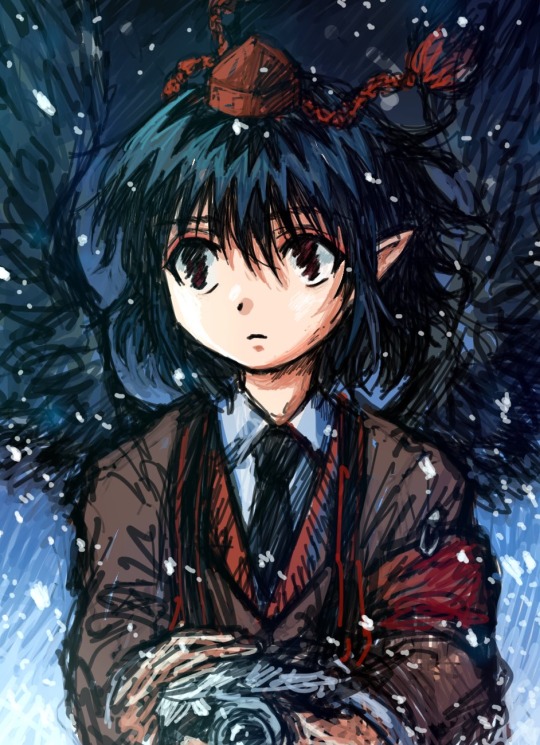
東方文花帖_射命丸文
#touhou#illustration#touhou fanart#touhou project#fanart#東方#射命丸文#touhou fuujinroku#touhou aya#aya#aya shameimaru#touhou bunkacho
157 notes
·
View notes
Text
Free idea
Touhou: Mountain of Faith but Sanae is a juggalo, complete with ICP-themed spell cards and Miracles as her battle theme
I wanna see her pull out like... Faygo Sign "PURE MOTHERFUCKIN' MAGIC" or whatever
#touhou#touhou project#touhou fuujinroku#mountain of faith#sanae kochiya#insane clown posse#miracles#juggalo
1 note
·
View note
Text
re: arcs in touhou
this is a personal way of packaging the events of touhou for convenience. literature not explicitly mentioned, I'd place in the corresponding release chronology.
1. PC-98
We all now by now that pc-98 canon is deemed mostly canon unless contradicted. It is also quite outdated and left for much of interpretation. Either way.
- Reiiden, (The) Highly Responsive to Prayers. What do we know? Reimu can seriously kick some ass. Also, joyful spherical creature.
- Fuumaroku, (the) Story of Eastern Wonderland. What do we have? Mima was apparently unsealed from Hell, and it's established that the Hakurei is famous for better or worse. Moreover the "true powers" of the orbs are quite curious.
- Yumejikuu, (The) Phantasmagoria of Dim. Dream. What do we have? Professor Yumemi Okazaki from a world that resembles the foundation of the Hifuuture. Also some insight into the whimsy of this world.
- Gensoukyou, Lotus Land Story. There isn't that much other than the name (!!!), Yuuka, and the existence of a dream world.
- Kaikidan, Mystic Square. There is once again not that much lore other than Makai having more of a structure and Alice appearing for the first time. Perhaps the mention that Yuuka doesn't use magic is of vague interest (and so would be Mima's words about being a god if she hadn't disappeared).
2. Spellcard Arc
Immediately following the Vampire Incident (which in and of itself is quite interesting for a variety of reasons) we get to watch as Gensokyo becomes used to this new system. This is an arc for Exposition.
- Koumakyou, (the) Embodiment of Scarlet Devil. We get it, Remilia wants to show off. We are introduced to Patchouli and Flandre, who are for now important to the lore.
- Youyoumu, Perfect Cherry Blossom. Of importance, we expand upon the fact that Gensokyo has History and that it has Connections to other worlds, at least one of which seems to be manageable by Yukari Yakumo (whom we also meet here and we get some interesting interactions with Reimu). We also see Alice again, and this implies a possible connection to Makai somewhere.
- Suimusou, Immaterial and Missing Power. We meet Suika, who has a great deal of importance as an oni, as Yukari's friend, and as one of the four that once controlled the mountain.
- Eiyashou, Imperishable Night. Oh, where to even start. We get more insight on Yukari through Stage 3, we learn of the Human Village (protected by a hakutaku, mind you), we learn about the Lunarians, and we learn about Mokou. This is Chekhov's gun, I dare say.
- Kaeizuka, Phantasmagoria of Flower View. Clearly there's not really a Major Incident per se, but we do get insight on Reimu's duties, the nature of Gensokyo, how Yuuka has become relatively quiet, and we get insight from Yukari through Seasonal Dream Vision.
- Bunkachou, Shoot the Bullet. Here, I'd also place the literature of this era as more exposition with fun bits of lore.
- Hourai Doll ~ Dolls in Pseudo Paradise, Night Trip to Rendaino ~ Ghostly Field Club, Changing Dreams in the Age of Science ~ Changeability of Strange Dream, East-West Tokaido ~ Retrospective 53 Minutes, and Celestial Wizardry ~ Magical Astronomy. Boy oh boy do we have a fun ride learning about the Hifuuture and our dear protagonists, Maeriberii "Maribel" "Merry" Hearn and Renko Usami. This is of great importance for Yukari and Gensokyo lore later on, plus it's a good segue into the more philosophical arc next.
(yes I know DiPP isn't strictly Hifuu but!)
3. Religious Arc
- Bougetsushou. This expands on Lunarian lore, which is especially important when we try to understand Yukari Yakumo and Gensokyo, and it complements well the established setting in the first half of Hifuu. We also get insight on Patchouli's magic-science unification, more on religious setting (as seen in Yorihime and maybe Yuyuko loopholeing the concept of purity), and more on History such as Mokou's past and Eirin's growth.
- Fuujinroku, Mountain of Faith. Well, other than welcoming a more divine side into Touhou, we establish properly the dynamics of the Youkai Mountain, especially the tengu's presence. Moreover, we meet Kanako and Suwako, who are living proof of gensokyo's concept of adaptation and self-definition, as well as of gensokyo's sustainable balance. Sanae is also a good way to expand on the relationship with the Outside World.
- Hisouten, Scarlet Weather Rhapsody. We are introduced to Tenshi and the philosophy of the Celestials, and also we see Yukari having a bit of an obvious interest in keeping the shrine as is.
- Chireiden, Subterranean Animism. We learn about Former Hell, continue to see Yukari and Suika being suspiciously helpful, meet Yuugi, and continue the trainwreck caused by Kanako's arrival.
- Seirensen, Undefined Fantastic Object. Makai returns! Byakuren is here! With her arrival, the Trainwreck continues, there is a vague connection to the Blood Pools via Murasa, and we get to see the side of mythology about humans and youkai (as seen with Byakuren's approach to it, and Ichirin existing).
- Hisoutensoku, Unthinkable Natural Law; Bunkachou, Double Spoiler; Sangetsusei, Great Fairy Wars. Naturally, we must see Gensokyo adapting to it's new state of affairs as things change and forces tug at it.
- Shinreibyou, Ten Desires. Much more lore regarding History and self-definition as seen in Miko; also, we meet Mamizou, who can somewhat play with the Hakurei Barrier.
- Shinkirou, Hopeless Masquerade. The Trainwreck comes to a close as Kokoro puts an end to the religious wars. This event (by which I mean a tsukumogami and a satori accidentally solving everything with some nudges along the way) show the way Gensokyo works: nothing truly Bad can happen to it.
- Suzunaan, Forbidden Scrollery. This further shows that there are forces at play which ensure the balance of Gensokyo. More on that in other official literature.
4. Gensokyo Arc
We are back to seeing the nature of this fantasy land through a much larger scope. Gensokyo has been established as a setting and as a concept, so now we get to see it in full action.
- Ruins of Torifune ~ Trojan Green Asteroid, Izanagi Object ~ Neo-traditionalism of Japan, Swallow stone Naturalis Historia ~ Dr. Latency's Freak Report, Old Testament Tavern ~ Dateless Bar "Old Adam". What a better way to start this era than through the moment in Hifuu where the Renko-Merry dynamic takes a turn, and Merry's true colors start to show more clearly?
- Kishinjou, Double Dealing Character. An independent incident, really; we are given a refreshment as to what a Gensokyo Incident feels like. No intervention from any other worlds, simply put. It's quickly resolved, as expected, and even quicker does the world adapt. (Insert ISC here).
- Shinpiroku, Urban Legend in Limbo. Much to discuss! From a new Outsider in the form of Sumireko Usami, to the scale that an incident can reach when there are other worlds at play! Especially, the Moon and an Outside World that ever so slightly drifts from what Sanae knew and into what Merry will know. Also, we get a proper game appearance for Kasen, which means...
- Ibarakasen, Wild and Horned Hermit. Sure, the story began much earlier, but it's worth nothing a few things here and now, such as the insight we get on being a hermit, a sage, and an oni all from the same person: Kasen, another prime example of self-definition. Also, a fun little peek at Hell and Heaven.
- Kanjuden, Legacy of Lunatic Kingdom. Well, among many other things, this brings us Hecatia, who offers good insight on the dynamic of connected worlds, which we have been seeing quite a lot of; as well as a comparison between the rigid Lunarian culture, the unique lawlessness of Hell, and the adaptable Gensokyo.
- Hyouibana, Antimony of Common Flowers. Well, with this incident we get to see more of Kasen and Yukari's current dynamic, their relation to Reimu, and two very important points shown through the Yorigamis: anyone can cause an incident (which, we kinda already knew, but bear with me), and the Dream World takes importance. Tenshi can freely desire to reshape the world into something better (albeit through odd means), is that not reminiscent of Reimu's desire?
- Tenkuushou, Hidden Star in Four Seasons. What was that about anyone crafting an incident? Oh yeah, another sage appears, and makes incision on the nature of Gensokyo. There is also, albeit not as directly, insight into self-definition in Okina, who embodies so many concepts.
- Hifuu Nightmare Diary, Violet Detector. More Sumireko shenanigans that showcase the adaptability of Gensokyo and the meddling of the sages when things are tricky. Moreover, the importance of the Dream World for Gensokyo is highlighted: both in universe, as the Yukaribel story grows, and out of universe, for the very conception of Gensoukyou involved a dream world.
- Kikeijuu, Wily Beast and Weakest Creature. Woop woop, there's no time to keep musing about sages and dreams, Hell is here! Is this a consequence of Hecatia and Okina's quarrel? No, it was actually the Beasts. However, we do get to see a curious phenomenon involving Keiki and the human spirits.
- Gouyoku Ibun, Submerged Hell of Sunken Sorrow. Once again, the sages meddle when things are tricky. There's also something to be said about their wisdom - are they not very clever with Flandre's power? They must've quickly learnt in order to devise such a plan - Kasen learnt to solve the Urban Legend Incident, Yukari learnt to solve the Perfect Possession Incident, surely Okina can do the same. And yet... perhaps, and just perhaps, the knowledge was always there. The Vampire Incident was long ago, and Gensokyo is fundamentally an accepting place. Had they wanted to, they could've kicked the Scarlets out, and yet. This is how they built Gensokyo. This is how they work with it. But let's move on - more Beast lore, and we utilize obscure mythology to our advantage.
This, we have already seen. Vampire lore is not exactly commonplace, so they didn't know how to deal with them. Oni lore was forgotten, therefore Suika and Kasen were tricky to deal with. The sages are masters of self-definition through their mythology. The entirety of shinpiroku and hyouibana was based on working with the mythology of the incident. More on this later.
- Kouryuudou, Unconnected Marketeers. Another instance of "anyone can create an incident if they try hard enough," of "redefining oneself" with Chimata and not too unlike what Kanako herself showed, and of Reimu finding more about her own power.
- Bulletphilia-tachi no Yami-Ichiba, 100th Black Market. Whimsical instance of Gensokyo adapts. Somehow, it always does, for better or worse.
- Juuouen, Unfinished Dream of All Living Ghost. Whuh-oh! This was the for worse! Now, the beast incident brewing in the background crashes into the ever fluctuating Gensokyo. Thankfully, even the other worlds have their own measures to remain stable, just like Gensokyo does. This means both through the dutiful shrine maiden and through this strange innate balance (Aunn saves the day! Okina will surely claim it was all according to plan). Everything passes.
5. The Future.
Who knows? Predicting touhou is famously not the best of ideas. However, I'm confident there will be constants: this is a place to determine oneself, and this is a place that will persevere.
On a more specific note, I imagine that Chireikiden, Cheating Detective Satori will bring an interesting plot, whether it be a conclusion to the arc or the beginning of a new one. We recently tackled Hell, so it may be the former option.
It seems to be shaping up a lore reveal regarding the Hakurei and Gensokyo's creation. Perhaps, there will be more on its connection to other worlds, specifically the dream world. The importance of change. The nature of the shrine. The balance established by the sages, of those who embrace otherness as seen in Hifuu, in DiPP, in Forbidden Scrollery.
#touhou#touhou project#gensokyo meta#goodness gracious who do i even tag#reimu hakurei#yukari yakumo#kasen ibaraki#okina matara#and many many others
38 notes
·
View notes
Text
my good friend [OST] TH10 Touhou Fuujinroku ~ Mountain of Faith - 8 - Fall of Fall ~ Akimeku Taki.........
31 notes
·
View notes
Note
If I want to get into Touhou lore, where should I start? the wiki is apparently unreliable, and from what i've played of the games they're rather low on details.
The wiki is fine- because it contains the entire text of all the print works and games (Generally, if something on the wiki has Japanese text on the left hand side and English text on the right hand side, like the following, it's reliable.)

The plaintext articles themselves are written by Touhou fans, which are an interesting bunch with their own ideas on everything and thus less reliable. But if you don't want to wikidive for translations, my personal recommendation of where to start is:
Touhou Suzunaan ~ Forbidden Scrollery
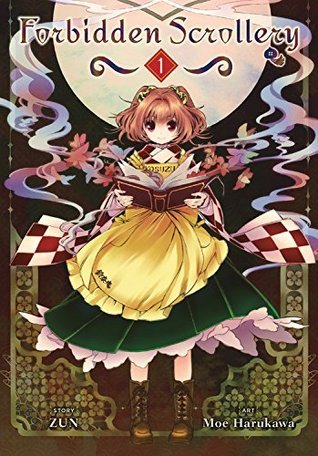
Volumes 1-7 (that is to say, the whole thing) are available for purchase on Amazon (in English) if you're into that sort of thing, but it's also on Mangadex and the like. It is a series from the perspective of a girl living in the human village, who knows very little about the broader workings of Gensokyo as a whole. As such, it's a very good introduction for a beginner (since you get to learn as she does).
After that, my recommendation is Wild and Horned Hermit (another manga, starring Ibaraki Kasen, a "hermit" and busybody), Perfect Memento in Strict Sense and Symposium of Post-Mysticism (text of these is available on the wiki), and any of the fighting games (they tend to be far more story-heavy than the shmups, but do require English patching. My first recommendation for these is Scarlet Weather Rhapsody, as it stars quite a lot of recurring characters, then Urban Legend in Limbo, followed by Antinomy of Common Flowers). As for the shooting games, their scripts are also available on the wiki, but if you want to actually play them, I recommend starting with Touhou Youyoumu ~ Perfect Cherry Blossom if you're willing to go for piracy, and Touhou Fuujinroku ~ Mountain of Faith if you're not (it's on Steam). There are also a couple of ongoing manga, but you might have a hard time following them if you're not up to date on some of the older print works.
If you want to understand what I refer to as "Hifuu", you'll want to read the stories of the music CDs (also on the wiki), starting with Ghostly Field Club (Dolls in Pseudo Paradise is its own thing). This is mostly self-contained, however (apart from some cross-references with a certain character).
That should be it, mostly! If you have an idea of what interests you the most about Touhou, let me know and I can find works catering to that particular interest.
47 notes
·
View notes
Text
List of Touhou games by whether the title refers to the final boss
Touhou Reiiden (Wondrous Tale) ~ Highly Responsive to Prayers (1): no. Japanese title is just "this is a story", English title doesn't mean anything.
Touhou Fuumaroku (Demon-Sealing Record) ~ Story of Eastern Wonderland (2): no. The English title is just "this is a story"; the Japanese title refers to the actions of the protagonist.
Touhou Yumejikuu (Dream Spacetime) ~ Phantasmagoria of Dim.Dream (3): not really. Both titles make a vague gesture towards the origins of the final bosses, but nothing concrete about the final boss herself.
Touhou Gensokyo ~ Lotus Land Story (4): no. Refers to itself and to nothing.
Touhou Kaikidan (Bizarre Romantic Story) ~ Mystic Square (5): no. Honestly not clear what either title referring to.
Touhou Koumakyou (Scarlet Devil Land) ~ The Embodiment of Scarlet Devil (6): no in the Japanese title, as it refers to the setting; yes in English, as the final boss is the Scarlet Devil (and, presumably, the embodiment of herself).
Touhou Youyoumu (Ghostly Dream) ~ Perfect Cherry Blossom (7): no in the Japanese title, arguably yes in the English title if you treat the Saigyou Ayakashi itself as "the final boss" for that last timeout-spellcard thing; otherwise no.
Touhou Suimusou (Gathering Reverie) ~ Immaterial and Missing Power (7.5): no in the Japanese title, as it refers to the Incident itself; arguably yes in the English title, as the final boss spends the majority of the game both immaterial and missing, and she is also the power itself.
Touhou Eiyashou (Eternal Night Vignette) ~ Imperishable Night (8): no. The imperishable/eternal night is caused by the protagonists as a response to the actual Incident.
Touhou Kaeizuka (Flower Reflecting Mound) ~ Phantasmagoria of Flower View (9): no in both cases; it refers to the Incident itself, without referring to the final boss per se (she's actually unrelated to the Incident since it's basically a natural phenomenon).
Touhou Bunkachou (Word Flower Album) ~ Shoot the Bullet (9.5): no. There isn't really a final boss per se, and both titles refer to the actions of the protagonist.
Touhou Fuujinroku (Wind God Chronicles) ~ Mountain of Faith (10): not really in the Japanese title -- the closest thing to a "wind god" is the stage 5 boss; in the English title, refers to the Incident more or less, since it's about gods coming to the mountain.
Touhou Hisouten (Scarlet Perception Heaven) ~ Scarlet Weather Rhapsody (10.5): refers to the Incident in both titles, without necessarily meaning the final boss herself.
Touhou Chireiden (Earth Spirit Palace) ~ Subterranean Animism (11): no. The Japanese title isn't even the location of the final boss, and the English title is just a reference to the overall setting.
Touhou Seirensen (Star Lotus Ship) ~ Undefined Fantastic Object (12): no. Generally speaking, both titles refer to an object connected to the final boss, but not the final boss herself.
Touhou Hisoutensoku ~ Choudokyuu Ginyoru no Nazo o Oe (Unperceiving of Natural Law ~ Chase the Enigma of the Gargantuan Guignol) (12.3): no. While it does refer to something specific ingame, nobody actually fights it, and each of the stories has a different final boss.
Double Spoiler ~ Touhou Bunkachou (Word Flower Album) (12.5): sort of in the English title, as the two protagonists are each other's final bosses; no in the Japanese title, as with Shoot the Bullet.
Yousei Daisensou (Great Fairy Wars) ~ Touhou Sangetsusei (Three Fairies) (12.8): refers to the Incident in the first part (insofar as a bunch of fairies getting into a scuffle can be considered "an Incident" rather than "a slightly unusual Tuesday", but I'm going for consistent terminology here), and technically yes in the case of the second part.
Touhou Shinreibyou (Divine Spirit Mausoleum) ~ Ten Desires (13): no in the Japanese title, which refers to the setting of the back half of the game; not really in the English title, which merely references an ability of the final boss but not the final boss herself.
Touhou Shinkirou (Heart Elegant Tower) ~ Hopeless Masquerade (13.5): no in the Japanese title, as there isn't even a tower, and basically yes in the English title.
Touhou Kishinjou (Shining Needle Castle) ~ Double Dealing Character (14): no in the Japanese title, which refers to the location of the final boss; in the English title, refers to the incident-causer, who is the stage 5 boss rather than the final boss.
Danmaku Amanojaku ~ Impossible Spell Card (14.3): no. The Japanese title refers to the player character (who is in fact the Double-Dealing Character of the previous game), and the English title refers to what you fight. There isn't really a final boss per se IIRC.
Touhou Shinpiroku (Deep Secret Record) ~ Urban Legend in Limbo (14.5): no in the Japanese title, as it refers to itself and to nothing, and refers to the Incident itself in the English title.
Touhou Kanjuden (Ultramarine Orb Tale) ~ Legacy of Lunatic Kingdom (15): no. The Japanese title refers to an element of Urban Legend in Limbo, and the English title refers to the location of stage four.
Touhou Hyouibana (Spirit Possession Bloom) ~ Antinomy of Common Flowers (15.5): refers to the Incident without necessarily meaning the final boss, in both the English and Japanese titles.
Touhou Tenkuushou (Heavenly Jade Dipper) ~ Hidden Star in Four Seasons (16): sort of in the Japanese title, which refers to a visual motif of the final boss, and yes in the English title.
Hifuu Nightmare Diary ~ Violet Detector (16.5): no. Refers to the actions of the protagonist in the first part, and the protagonist herself in the second part.
Touhou Kikeijuu (Oni-Shaped Beast) ~ Wily Beast and Weakest Creature (17): in both titles, refers to the incident-causer, who is not the final boss.
Touhou Gouyoku Ibun (Strange Tale of Avarice) ~ Sunken Fossil World (17.5): no. The Japanese title is "this is a story", the English title refers to the setting.
Touhou Kouryuudou (Rainbow Dragon Cave) ~ Unconnected Marketeers (18): no. The Japanese title refers to the location of stage four, and as for the English title, the last few bosses are very much connected.
Bulletphilia-tachi no Yami-Ichiba (Bulletphiles' Black Market) ~ 100th Black Market (18.5): no. Refers to the general setup.
Touhou Juuouen (Beast King Garden) ~ Unfinished Dream of All Living Ghost (19): no. The Japanese title refers to the general setting, and the English title refers to a concept.
25 notes
·
View notes
Text
the mountain god saejima trains with in yakuza 5 shouldve been living god kochiya sanae from touhou fuujinroku ~ mountain of faith he would learn to shoot projectile attacks and some such
14 notes
·
View notes
Text
DISCOGRAPHY
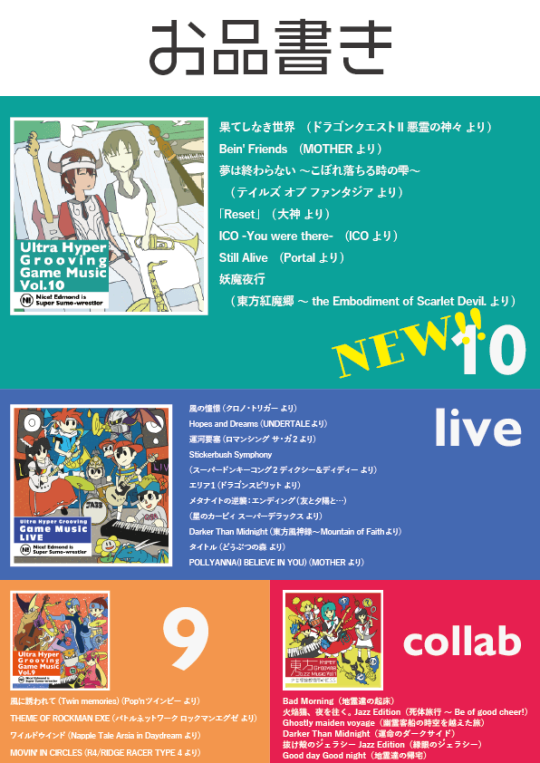

▼Ultra Hyper Grooving Game Music Vol.1
1.王子の冒険 (カエルの為に鐘は鳴る より)
The Prince's Adventure (from "For Frog the Bell Tolls")
2.ピラプト王国 (スーパーマリオランド より)
Birabuto Kingdom (from "Super Mario Land")
3.Eyes On Me (ファイナルファンタジーⅧ より)
Eyes On Me (from "FINAL FANTASY Ⅷ")
4.ビコーズ・アイ・ラブ・ユー (MOTHER2 ギーグの逆襲 より)
Because I Love You (from "EarthBound")
▼Ultra Hyper Grooving Game Music Vol.2
1.ポリアンナ (MOTHER より)
Pollyanna (from "EarthBound Zero")
2.憩いの町 (不思議のダンジョン2 風来のシレン より)
Mountaintop Town (from "Shiren the Wanderer")
3.クロノ・トリガー (クロノ・トリガー より)
Chrono Trigger (from "Chrono Trigger")
4.Time is changing (ダーククロニクル より)
Time is changing (from "Dark Chronicle")
▼Ultra Hyper Grooving Game Music Vol.3
1.Snakey Chantey(スーパードンキーコング2 より)
Snakey Chanty(from "Donkey Kong Country 2: Diddy's Kong Quest")
2.Escape From The City(ソニックアドベンチャー2 より)
Escape From The City(from "SONIC ADVENTURE2")
3.サラダロアの町/サラダ町奉行所(サラダの国のトマト姫 より)
Saladoria/The Prison(from "Princess Tomato in the Salad Kingdom")
4.レイトン教授のテーマ(レイトン教授と不思議な町 より)
Professor Layton's Theme(from "Professor Layton and the Curious Village")
5.タイトル(どうぶつの森 より)
Title(from "Animal Crossing")
▼Ultra Hyper Grooving Game Music Vol.4
1.あさってCOLOR(スプラトゥーン2 より)
Fresh Start(from "Splatoon 2")
2.Historic Soldier(グラディウス より)
Historic Soldier(from "Nemesis")
3.Radical Dreamers ~盗めない宝石~(クロノ・クロス より)
Radical Dreamers ~Unstolen Jewel~(from "Chrono Cross")
4.Sagat Stage(ストリートファイターII より)
Sagat Stage(from "Street Fighter II")
▼Ultra Hyper Grooving Game Music Vol.5
1.Hopes and Dreams(UNDERTALE より)
Hopes and Dreams(from "UNDERTALE")
2.愛のテーマ(ファイナルファンタジーIV より)
Theme of Love(from "Final Fantasy IV")
3.UNTAMED HEART(風のクロノア door to phantomile より)
UNTAMED HEART(from "Klonoa: Door to Phantomile")
4.Dreams Dreams(ナイツ NiGHTS into Dreams… より)
Dreams Dreams(from "NiGHTS into dreams…")
▼Ultra Hyper Grooving Game Music Vol.6
1.海ステージ(星のカービィ スーパーデラックス より)
Sea Stage(from "Kirby Super Star")
2.ひまわりとまぼろし/おかあさん?!(MOTHER3 より)
Sunflowers and Illusions/Mother?!(from MOTHER3)
3.君と二人で~ある新米鍛冶師の場合~(サモンナイト クラフトソード物語 より)
Together With You ~A Certain Rookie Blacksmith~(from "Summon Night: Swordcraft Story")
4.ヨッシーのうた(ヨッシーストーリー より)
Yoshi's Song(from "Yoshi's Story")
▼Ultra Hyper Grooving Game Music Vol.7
1.おおぞらをとぶ(ドラゴンクエストIII そして伝説へ… より)
Heavenly Flight(from "Dragon Warrior III")
2.剣入手前フィールド(ゼルダの伝説 夢をみる島 より)
Sword Search(from "The Legend of Zelda: Link's Awakening")
3.FLASHMAN STAGE(ロックマン2 Dr.ワイリーの謎 より)
FLASHMAN STAGE(from "Mega Man 2")
4.Stickerbrush Symphony(スーパードンキーコング2 より)
Stickerbrush Symphony(from "Donkey Kong Country 2: Diddy's Kong Quest")
▼Ultra Hyper Grooving Game Music Vol.8
1.作戦~ラストバトル オープニング(スプラトゥーン2 より)
The Plan ~ Last Battle Opening(from "Splatoon 2")
2.フライ・オクト・フライ
Fly Octo Fly
3.フルスロットル・テンタクル
Ebb & Flow
4.フレンド・フロム・ファラウェイ
Into the Light
▼Ultra Hyper Grooving Game Music Vol.9
1.風に誘われて (Twin memories)(Pop'nツインビー より)
Calling for the wind (Twin Memories)(from "Pop'n Twinbee")
2.THEME OF ROCKMAN EXE(バトルネットワーク ロックマンエグゼ より)
THEME OF ROCKMAN EXE(from "Mega Man Battle Network")
3.ワイルドウインド(Napple Tale Arsia in Daydream より)
Wild Wind(from "Napple Tale: Arsia in Daydream")
4.MOVIN' IN CIRCLES(R4/RIDGE RACER TYPE 4 より)
MOVIN' IN CIRCLES(from "R4/RIDGE RACER TYPE 4")
▼Ultra Hyper Grooving Game Music LIVE
1.風の憧憬/クロノ・トリガー
Wind Scene/Chrono Trigger
2.Hopes and Dreams/UNDERTALE
Hopes and Dreams/UNDERTALE
3.運河要塞/ロマンシング サ・ガ2
Canal Fortress/Romancing Sa・Ga2
4.Stickerbush Symphony/スーパードンキーコング2 ディクシー&ディディー
Stickerbush Symphony/Donkey Kong Country 2: Diddy's Kong Quest
5.エリア1/ドラゴンスピリット
AREA1/DRAGON SPIRIT
6.メタナイトの逆襲:エンディング(友と夕陽と…)/星のカービィ スーパーデラックス
Revenge of Meta-Knight Ending Theme/Kirby Super Star
7.Darker Than Midnight/東方風神録~Mountain of Faith 運命のダークサイド(Dark Side of Fate)
Touhou Fuujinroku~Mountain of Faith
8.タイトル/どうぶつの森
Title/Animal Crossing
9.POLLYANNA(I BELIEVE IN YOU)/MOTHER
POLLYANNA(I BELIEVE IN YOU)/MOTHER
▼Ultra Hyper Grooving Game Music Vol.10
1.果てしなき世界(ドラゴンクエストII 悪霊の神々 より)
Endless World(from "Dragon Quest II: Luminaries of the Legendary Line")
2.Bein' Friends(MOTHER より)
Bein' Friends(from "EarthBound Beginnings")
3.夢は終わらない 〜こぼれ落ちる時の雫〜(テイルズ オブ ファンタジア より)
Yume Wa Owaranai ~Kobore Ochiru Toki no Shizuku~(from "TALES OF PHANTASIA")
4.「Reset」(大神 より)
「Reset」(from "Ōkami")
5.ICO -You were there-(ICO より)
ICO -You were there-(form "ICO")
6.Still Alive(Portal より)
Still Alive(from "Portal")
7.妖魔夜行(東方紅魔郷 〜 the Embodiment of Scarlet Devil. より)
Apparitions Stalk the Night(from "Touhou Koumakyou: The Embodiment of Scarlet Devil")
7 notes
·
View notes
Text
I wish there was, like, a way to see the history of a certain Twitter @. Like I wanna know how many hands Fuujinroku passed through before I started using it on there.
3 notes
·
View notes
Note
2
3 (Why specifically?)
6
2 -> Probably illusionary Joururi or Shanghai Alice eof Meiji 17
3 -> Kishinjou, my favorite game ever... idk why I like it that much... maybe because of the banger OST.... or I just like the characters.
6 -> Hakurei shrine because it took me a long time to beat sanae when I played fuujinroku
5 notes
·
View notes
Text









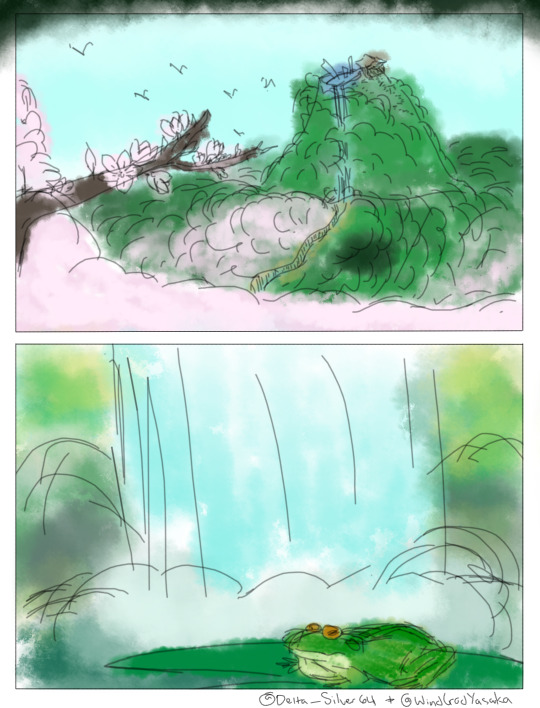


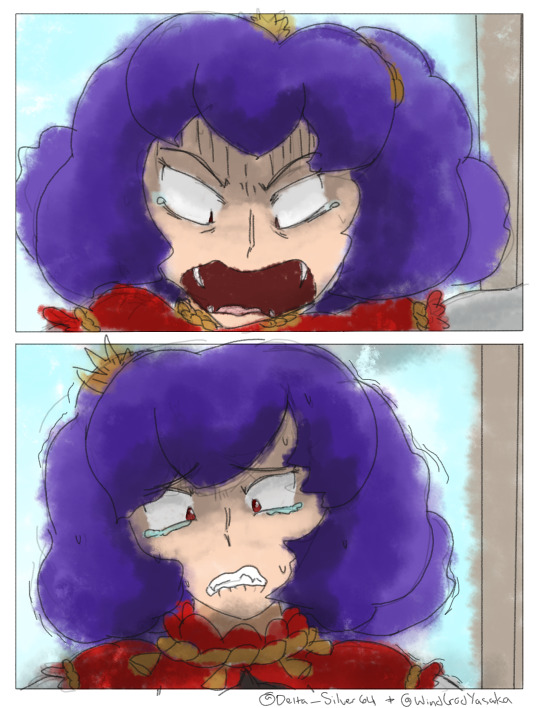

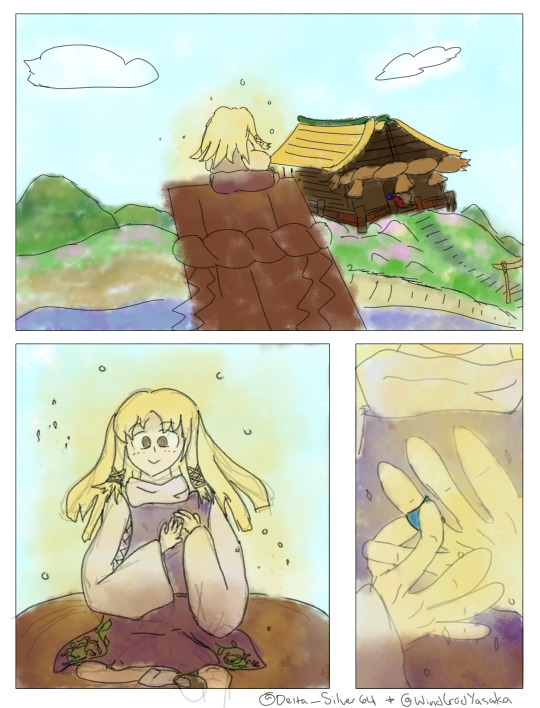




Spring of Moriya
I made a comic based off something from an rp. Context isn't really necessary to enjoy this, but if you'd like the backstory and my thoughts on this, you can keep reading.
My buddy who was rping as Suwako took a break over January and February, and we joked on it as Suwako going into brumation for the winter as most frogs do. Then around March, they decided to stop rping on twitter entirely, which I supported since twitter is a bit of a drain if you don't have an established friend group there. (The Sanae account also left a little while earlier, which is why I mentioned the thing about Sanae on page 5.)
So, with this in mind, I made a comic detailing what would happen if Suwako were to fade away for good, all while there was nothing Kanako could do to stop it this time.
After working on this thing for a while, it just seems like an overtly sad comic with a bad ending to me. Maybe even a bit to the point where I find it pathetically funny. My friends found it genuinely sad, though, so maybe that says more about me.
This wasn't intended to be published on april fools, but procrastination is also a bitch so what can ya do
Happy Spring, and cherish those who are with you. You never know when there will be a last time. :)
#touhou project#touhou#kanako yasaka#mountain of faith#suwako moriya#suwakana#fuujinroku#touhou fanart#touhou comic
26 notes
·
View notes
Text
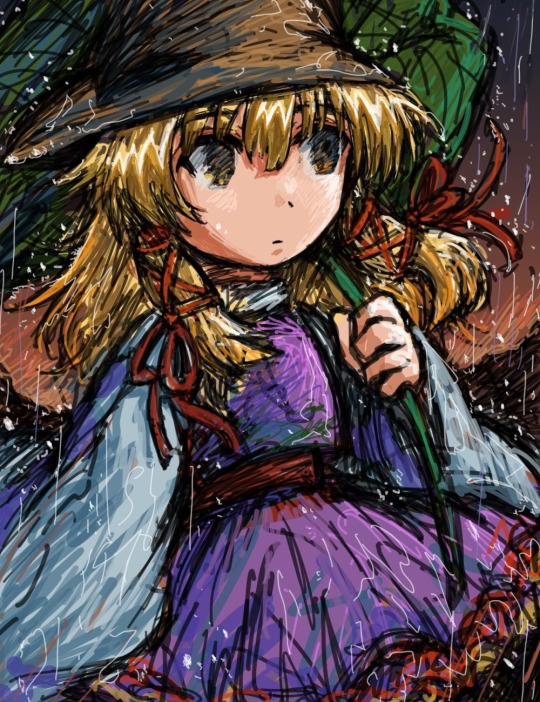
東方風神録_洩矢諏訪子
#touhou#illustration#touhou fanart#touhou project#fanart#東方#洩矢諏訪子#touhou fuujinroku#suwako#suwako moriya#rain#touhou suwako
127 notes
·
View notes
Text
Media Log 2024 Entry 5 - Touhou Fuujinroku - Mountain of Faith - 5/5

Moriya Shrine > Hakurei Shrine. This is objective fact.
With how good ZUN is at making bullet hell games, is it any wonder he's made so many?
Mountain of Faith is yet another example of shmup excellence and really demonstrates how creative ZUN can get with spell cards. Besides that, it is a very basic game with regards to mechanics. The most unique things about its mechanics are that the two playable characters each have three shot types and the single negative about it: your bombs use shot power. I don't like this because it makes me too anxious to use bombs because if you use them too much your bullets get weaker.
Besides that single hiccup, Mountain of Faith has great stages, great music, and great spell cards (and Kappa's Pororoco, but we can't all be winners). What really wowed me were the cool setpieces and backgrounds throughout the game - best of all being the previously referenced waterfall that comprises all of stage 4, where enemies pop out from behind it! It's super fun! I also like how stage 2 has Hina appearing intangible and spawning enemies at first before starting her spell card as a midboss, and how in stage 3, Nitori runs away from you at first.
Overall, it's a really great game. It's the second oldest Touhou game available on Steam, and I think its price tag is well worth it. Give it a shot - maybe, like me, you'll realize that shmups were what you needed in your life all this time.
#media log#media log 2024#edit: apparently phantasmagoria of flower view is on steam. who knew? that makes MoF the second oldest TH game on steam
1 note
·
View note
Text
hmmmmmmmmmmmmmmmm
1) damn yuugi. I think I hauve covid.
2) damn yuugi. This is gonna be quite troublesome.
3) damn yuugi. With suika being buddy buddy with yukari still and kasen being kasen, I am increasingly more curious about your story. Going against gensokyo?
3.2) at this moment, we remember hecatia's interview very dearly.
4) damn yuugi. You really think you and mizuchi are gonna win? I severely doubt it
4.2) unless this marks a new era for gensokyo which ... I doubt would remain contained via manga format. and juuouen already tackled some heavy shit.
4.3) touhou twenty does seem like an adequate point to make something large happen. Throwback to fuujinroku I guess?
4.3.2) which would also sit nicely with fuujinroku-fuumaroku and the whole mizuchi mima hakurei wishy washy business.
4.3.3) touhou 20: the shinkirou of the gensokyo arc
5) damn byakuren. fourth walls are like paper to you hmm?
3 notes
·
View notes
Text

38 notes
·
View notes